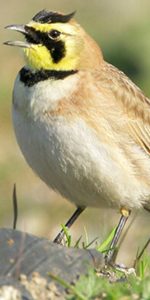| Horned Lark | ||
 |
Classification(s) : | Prey |
| Cat Name : | Capped Sparrow | |
| Common Name : | Horned Lark | |
| Scientific Name : | Eremophila alpestris | |
| Other Name(s) : | ||
| Physical Description : | The Horned Lark is a small songbird recognized by the tufts of feathers, or “horns”, on its head. The bird’s back is a pale brown and a yellow or pale beige throat. It has a diamond shaped patch of black plumage on its chest and a black patch on its face stretching from its lower jaw to its beak. |
|
| Physical Statistics : | Length – 6.3 – 7.9 in (16 – 20 cm) |
|
| Behavior : | Horned Larks widely populate open grasslands and moors, and they forage for seeds and insects. They like to stay in large groups but try not to mix with other types of birds, because it is aggressive. |
|
| Social Organization : | Horned Larks tend to stay in large flocks whether flying, nesting, or foraging. |
|
| Approval Level : | None; Horned Larks are found almost everywhere in fields, moors, and grasslands, though they tend to avoid woodland areas. | |
| Kill Difficulty : | Moderate; The Horned Lark may be small, but it is armed with sharp claws and beak and is aggressive. |
|
| Training Level : | Specialty - Group Flying; Horned Larks need to be isolated before hunting, because they will gang up on predators. |
|
| Hunting Tactic : | Songbirds | |
| Food Quality : | Medium; The Horned Lark is small, but delicious and nutritious. | |
